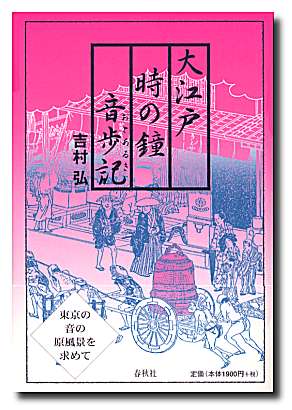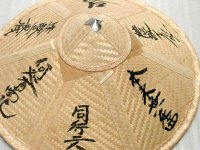[ . BACK to WORLDKIGO . TOP . ]
::::::::::::::::::::::::::::::::::::::::::::::::::::::::::::::::::::::::::::::::::::::::::::::::::::::::::::::::::::::::::::::::::::::::::::::::::::::::::::::::::::::::::::::::::::::::::::::::::::::::::::::
- kire 切れ and kireji 切字 - cut and cut markers - caesura -
Some sources state that all the 48 "letters (mora)" of the Japanese IROHA-alphabet can be used as kireji. Basho already said so when teaching his students (Kyoraisho 去来抄).
quote
Matsuo Basho and the Poetics of Scent
The hokku has changed repeatedly since the distant past, but there have been only three changes in the nature of the haikai link. In the distant past, poets valued word links (kotoba-zuke). In the more recent past, poets have stressed content links (kokoro-zuke). Today, it is best to link by transference (usuri), reverberation (hibiki), scent (nioi), or status (kurai).
Unlike, earlier renga and haikai handbooks, which address the question of which particular words or syllables can be used as cutting words, Basho discusses kireji in terms of function and effect.
In Kyoyaisho, Basho noted:
"First, the cutting word is inserted in order to cut the verse. If the verse is already cut, it is not necessary to employ a word to cut it. For those poets who cannot distinguish between a cut and non-cut poem, earlier poets established cutting words. If one uses one of these words in a hokku, seven or eight times out of ten the hokku will be cut. The remaining two or three, however, the hokku will not be cut even though it includes a cutting word. On the other hand, there are hokku that are cut even though they include no cutting words. "
(NKBZ 51:478-79)
For Basho, it was the cutting effect rather than the cutting word itself that ultimately mattered. A hokku could be cut without a kireji, and the use of a cutting word did not necessarily ensure that a hokku had been cut.
. . .the cutting word had the paradoxical function of both cutting and joining . . .
source : Haruo Shirane
quote
"A verse without a cutting word does not have the form of a hokku, or opening
verse. Instead, it takes the shape of an added verse.
Even if a cutting word is added to the hokku, it may still take the form of an added verse. These are verses that have not been truly cut."
- Matsuo Basho, Sanzooshi 三冊子 Sanzoshi
The use of a cut marker does not automatically imply a "juxtaposition" of two images/themes.
. WKD : kireji 切字 cut markers and kire 切れ the CUT .
under construction
::::::::::::::::::::::::::::::::::::::::::::::::::::::::::::::::::::::::::::::::::::::::::::::::::::::::::::::::::::::::::::::::::::::::::::::::::::::::::::::::::::::::::::::::::::::::::::::::::::::::::::::
Basho often uses the cut marker
KANA かな / 哉 at the end of line 3.
That way the hokku is usually one sentence, with one theme.
Hokku of this kind do not have a juxtaposition.
There are too many to list them here.
Check out the ABC pages of this BLOG !
MORE
. - One sentence - one theme hokku by Basho - .
::::::::::::::::::::::::::::::::::::::::::::::::::::::::::::::::::::::::::::::::::::::::::::::::::::::::::::::::::::::::::::::::::::::::::::::::::::::::::::::::::::::::::::::::::::::::::::::::::::::::::::::
- - - - - the cut marker YA
This cut marker is usually used at the end of line 1 or 2.
Basho also uses it
in the middle of line 1.
But it does not always imply a "juxtaposition" of two images.
これや世の煤に染まらぬ古合子
. kore ya yo no susu ni somaranu furu gooshi / goosu / gabushi .
Basho also uses it more often
in the middle of line 2. But it does not always imply a "juxtaposition" of two images.
秋に添うて行かばや末は小松川
. aki ni soute yukaba ya sue wa Komatsugawa .
土手の松花や木深き殿造り
. dote no matsu hana ya ko bukaki tono-zukuri .
古き名の角鹿や恋し秋の月
. furuki na no Tsunuga ya koishi aki no tsuki .
冬牡丹千鳥よ雪のほととぎす
. fuyu botan chidori yo yuki no hototogisu.
冬しらぬ宿やもミする音あられ
. fuyu shiranu yado ya momi suru oto arare .
初真桑四つにや断たん輪に切らん
hatsu makuwa yotsu ni ya tatan wa ni kiran
. hatsu makuwa yotsu no ya kiran wa ni kiran .
人も見ぬ春や鏡の裏の梅
. hito mo minu haru ya kagami no ura no ume .
一時雨礫や降つて小石川
. hito shigure tsubute ya futte Koishikawa .
ほととぎす鳴くや五尺の菖草
hototogisu / naku ya go shaku no / ayamegusa
いかめしき音や霰の檜木笠
. ikameshiki oto ya arare no hinoki-gasa .
熊坂がゆかりやいつの玉祭
. Kumasaka ga yukari ya itsu no tama matsuri .
見送りのうしろや寂し秋の風
. miokuri no ushiro ya sabishi aki no kaze .
思ひ立つ木曽や四月の桜狩り
. omoitatsu Kiso ya shigatsu no sakuragari .
桜狩り奇特や日々に五里六里
. sakuragari kidoku ya hibi ni go ri roku ri .
しばし間も待つやほととぎす千年 - しばし間も待つやほととぎ 数千年
. shibashi ma mo matsu ya hototogi su sennen .
しほらしき名や小松吹萩すゝき
. shiorashiki na ya komatsu fuku hagi susuki .
その形見ばや枯木の杖の長
. sono katachi miba ya kareki no tsue no take .
姥桜咲くや老後の思い出
. ubazakura saku ya roogo no omoi-ide .
梅白し昨日や鶴を盗まれし
. ume shiroshi kinoo ya tsuru o nusumareshi .
埋火も消ゆや涙の烹ゆる音
. uzumi-bi mo kiyu ya namida no niyuru oto .
my tears make a hissing sound
- - - - -
稲雀茶の木畠や逃げ処
. inasuzume cha no kibatake ya nigedokoro .
sparrows in the rice paddies
This hokku has the cut marker YA at the end of line 2,
but in fact line 1 is separate and lines 2 and 3 belong together.
- - - - -
いでや我よき布着たり蝉衣
.ide ya ware yoki nuno kitari semi-goromo .
This hokku has the cut marker YA in the middle of line 1.
又やたぐひ長良の川の鮎膾
. mata ya tagui Nagara no kawa no ayu namasu .
This hokku has the cut marker YA in the middle of line 1
(and 6 onji in line one).
- - - - - And here is another interesting example:
荻の穂や頭をつかむ羅生門
ogi no ho ya kashira o tsukamu Rashoomon
Written in autumn of 1691 in Kyoto, 元禄4年秋
Basho captures the spooky atmosphere around the haunted Rashomon gate quite well.
MORE about this legendary gate
and its demon with the arm hacked off . . .
. The Rashomon Gate in Kyoto 羅生門 .

This hokku has the cut marker (kireji) YA at the end of line 1,
but lines 1 and 2 belong together ...
ogi no ho GA kashira o tsukamu
Surely Basho could have worded this different to place the cut marker at the end of line 2.
but he did not.
So here the cut marker creates the effect of "cut the hokku and continue theme".
Here are some paraverses :
this tip of a reed -
it seems to grab my head
near Rashomon Gate
.
no, there is no connection between line 2 and 3 in the Japanese
the plume of this reed
seems to grab my head -
Rashomon Gate
.
this ogi plume - whow -
now it grabs my head - whow
Rashomon Gate
Tr. Gabi Greve
the tip of a reed -
it grips the intellect
Rashomon Gate
... And I can see no real indication that a conjunction between the second and third images should be given in English. I can see no semanitc tie between the second and third metrical feet of the Japanese; 羅生門 stands alone, as far as I can see.
Tr. John Carley
this ear of a reed
caught on my head -
across Rashomon Gate
.
this tip of a reed
haunts my head -
Rashomon Gate
The ear of 荻 grows often as high as 1 and a half meters.
Tr. Hideo Suzuki
ogi no ho 荻の穂 plume of a reed, tip of a reed,
Miscanthus sacchariflorus
Basho uses OGI instead of susuki reed grass, since it has a punning effect with
oni - the demon of the Rashomon gate - remarks Robin Gill.
- MORE - Shared by friends of facebook -
. . . . .
reed plumes
I fear they might seize my head
at Rashomon
Tr. Jane Reichhold
.............................................................................
古池や
. furu ike YA kawazu tobikomu .
furu ike NI kawazu tobikomu
By using the cut marker YA at the end of line 1,
Basho cuts the poem but the theme continues --- the frog jumps into the old pond.
- - - - - YA used twice - - - - -
被き伏す蒲団や寒き夜やすごき
. kazuki fusu futon ya samuki yo ya sugoki .
This hokku has the cut marker YA in the middle of line 2,
and another YA in the middle of line 3.
Here the cut markers carries the emotion of "stress and continue".
It helps to emphasize the last word he uses:
sugoki, sugoi 凄い, which is a rather strong emotion: how dreadful!
- - - - -
 source : itoyo/basho
source : itoyo/basho
白河の関 Shirakawa no Seki
田や麦や中にも夏のほととぎす
ta ya mugi ya naka ni mo natsu no hototogisu
rice fields and barley -
and among them also
summer's cuckoo
Tr. Barnhill
fields of rice and barley --
above all (among others, especially)
summer Hototogisu
Tr. Naotaka Uematsu
Written in 1689 on the 7th day of the 4th lunar month.
元禄2年4月7日 Oku no Hosomichi
- - - Station 10 - Shirakawa no Seki 白川の関 - - -
. Matsuo Basho 松尾芭蕉 - Archives of the WKD .
- - - - - ta YA mugi YA
the two YA in line one could be interpreted as two times the cut marker YA
the rice paddies - the barley fields -
or
ta ya mugi (YA) - fields
and barley (cut marker)
The translation of hototogisu :
. - hototogisu 郭公 / ほととぎす -
.
The translation of mugi
. Barley, wheat (mugi) .
barley, "large mugi", oomugi, 大麦
Hordeum vulgare
wheat, "small mugi" komugi, 小麦
Triticum aestivum
::::::::::::::::::::::::::::::::::::::::::::::::::::::::::::::::::::::::::::::::::::::::::::::::::::::::::::::::::::::::::::::::::::::::::::::::::::::::::::::::::::::::::::::::::::::::::::::::::::::::::::::
YA at the end of line 3
明日は粽難波の枯葉夢なれや
. asu wa chimaki Naniwa no kareha yume nare ya .
山吹の露菜の花のかこち顔なるや
. yamabuki no tsuyu na no hana no kakochigao naru ya .
::::::::::::::::::::::::::::::::::::::::::::::::::::::::::::::::::::::::::::::::::::::::::::::::::::::::::::::::::::::::::::::::::::::::::::::::::::::::::::::::::::::::::::::::::::::::::::::::::::::::::::::
- - - - - the cut marker YO
YO not only used as a cut marker in hokku/haiku, but it is also used in normal Japanese to express astonishment, whow, exclamation, surprize . . .
anaka san yo - Hey Mister Tanaka!
白菊よ白菊よ恥長髪よ長髪よ
. shira-giku yo shiragiku yo haji naga kami yo naga kami yo .
::::::::::::::::::::::::::::::::::::::::::::::::::::::::::::::::::::::::::::::::::::::::::::::::::::::::::::::::::::::::::::::::::::::::::::::::::::::::::::::::::::::::::::::::::::::::::::::::::::::::::::::
- - - - - the cut marker KA - - - - -
often equivalent to a question mark ?
- - - in the middle of line 2
郭公招くか麦のむら尾花
hototogisu / maneku ka mugi no / mura obana
松風の落葉か水の音涼し
. matsukaze no ochiba ka mizu no oto suzushi .
::::::::::::::::::::::::::::::::::::::::::::::::::::::::::::::::::::::::::::::::::::::::::::::::::::::::::::::::::::::::::::::::::::::::::::::::::::::::::::::::::::::::::::::::::::::::::::::::::::::::::::::
Works by Helen Shigeko Isaacson
On YA and KANA, the „cutting particles" of haiku.
200 haiku of Basyoo in translation
Ya kana
One of the major barriers to an understanding of haiku in the West is that up till now, translators have avoided the entire subject of the untranslatable particles, ya and kana. In fact these are of the greatest importance, and it is impossible that anything sensible can ever be made out about haiku without studying them. Using as guidelines what old haizin 1 wrote about the particles, an attempt will be made in this chapter to illuc
cidate on this most difficult subject.
To try to explain a haiku without taking into account
ya , kana and keri is like explaining a poem in any language and leaving out one or two words. Especially in a haiku, where there are only seventeen syllables, every syllable is of utmost importance.
Some translators have tried to render the effect of these particles by exclamation points, dashes, and so on, but as will be made clearer, it is not only their effect, but specifically their particular sounds, that must be represented.
All language is inseparable from sound, but there is no language more uniquely based on sound as the Japanese, as has been briefly explained in the introduction to this book. Furthermore, the haiku, the last and briefest form of Japanese literature to evolve, combines most completely the power of word and sound ...
- source : Helen Shigeko Isaacson -
::::::::::::::::::::::::::::::::::::::::::::::::::::::::::::::::::::::::::::::::::::::::::::::::::::::::::::::::::::::::::::::::::::::::::::::::::::::::::::::::::::::::::::::::::::::::::::::::::::::::::::::
. WKD : kireji 切字 cut markers and kire 切れ the CUT .
. Cultural Keywords used by Basho .
[ . BACK to DARUMA MUSEUM TOP . ]
[ . BACK to WORLDKIGO . TOP . ]
::::::::::::::::::::::::::::::::::::::::::::::::::::::::::::::::::::::::::::::::::::::::::::::::::::::::::::::::::::::::::::::::::::::::::::::::::::::::::::::::::::::::::::::::::::::::::::::::::::::::::::::






















